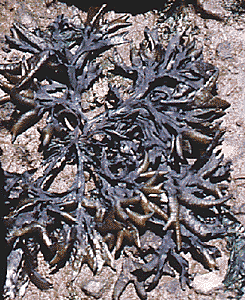 |
The largest of the chromists are the Phaeophyta, the brown algae -- the largest brown algae may reach over 30 meters in length. The rockweed shown at left, Fucus distichous, visible at low tide at the Berkeley Marina in California, is somewhat smaller. Almost all phaeophytes are marine. Phaeophytes, like most photosynthetic protists, have traditionally been classified as plants. However, phaeophytes are not closely related to land plants; their cells contain different pigments, such as chlorophyll c and fucoxanthin. They also lack the plasmodesmata and starch production of land plants and their relatives. Like plants and many protists, brown algae undergo a complex life cycle involving alternation of generations. In this picture, you can see a diploid kelp with flat photosynthetic structures, the blades, branching from the stipe, or stalk. The "puffy" regions attached to the blades are receptacles, structures in which the gametes are produced. |






